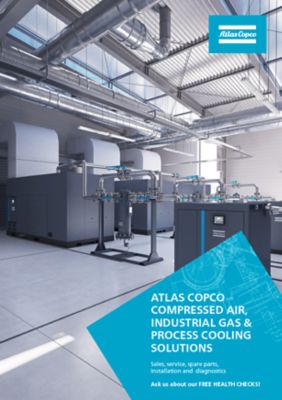Dimensioning Compressor Installations at High Altitude
Both the ambient pressure and temperature decrease with altitude above sea level. This lower inlet pressure impacts the pressure ratio, for the compressors as well as for the connected equipment, which, in practice, signifies an impact on both power consumption and air consumption. At the same time, the changes due to higher altitude will also affect the available rated power from electric motors and from combustion engines.
How does altitude influence compressor installations?
The way in which ambient conditions influence the end consumer application must also be taken into account. Is a specific mass flow rate (in a process) or a
volume flow rate required? Was the pressure ratio, absolute pressure or gauge pressure used for dimensioning? Is the compressed air temperature significant? All of these considerations create different conditions for
dimensioning a compressed air installation installed at a high altitude and can be fairly complex to calculate.
What effect does altitude have on the compressor choice?
To choose the correct compressor where the ambient conditions differ from those stated on the data sheet, the following factors should be taken into consideration:
- height above sea level or ambient pressure
- ambient temperature
- humidity
- coolant temperature
- type of compressor
- power source
These factors primarily affect the following:
- max. working pressure
- capacity
- power consumption
- cooling requirement
The most important factor is the inlet pressure variations at altitude. A compressor with a pressure ratio of 8.0 at sea level will have a pressure ratio of 11.1 at an altitude of 3000 meters (pro-vided that the application's operating pressure is unchanged). This affects the efficiency and, consequently, the power requirement. The amount of change is dependent on the type of compressor and the design. The ambient temperature, humidity and coolant temperature all interact and affect the compressor performance to different degrees on single-stage or multi-stage compressors, dynamic compressors or displacement compressors.
How does altitude affect electric motors?
Cooling is impaired on
electric motors by the lower density air at high altitudes. Standard motors should be able to work up to 1000 m and with an ambient temperature of 40°C without any impacts on rated data. At higher altitudes, the table below can be used as a guide for standard motor performance deration. Note that for some compressor types, the electric motor performance is impaired more than the compressor requisite shaft power at high altitude. Therefore, operating a standard compressor at high altitude requires lowering the working pressure or else fitting an oversized motor.
How does altitude affect internal combustion engines?
A reduction in ambient pressure, temperature increase or reduction in humidity reduces the oxygen content in the air used for combustion and, consequently, the extractable power from the internal combustion (IC) engine. The degree of shaft power deration depends on the type of engine and its breathing method (naturally aspirated or turbocharged) as set out in the table below. The humidity plays a smaller role (de-ration <1% per 1000 m) when the temperature falls below 30°C.
Note that the engine power falls more rapidly than the compressor requisite shaft power. This implies that for each compressor/engine combination, there is a maximum working height that will use the entire power margin of the engine over the compressor for use at sea level. Generally, suppliers should be entrusted with calculating and stating the specific data that applies to the compressor, engine and air consumption equipment in question. If anything is unclear or for any questions, the installer should always contact the equipment manufacturer.
Read more on the different aspects of dimensioning compressor installations below.
Related articles
31 May, 2022
Installing a compressor system is easier than it used to be. There are still a few things to keep in mind though, most importantly where to place the compressor and how to organise the room around the compressor. Learn more here.
30 June, 2022
There are a lot of things you have to consider when choosing an air compressor for your business. In this article we will explain what compressor is best suited for you, based on your application and needs.
3 August, 2022
Winter weather can expose your compressed air system to certain risks. Get a head start to make sure your compressor survives the year’s most wonderful time by following these simple steps.




